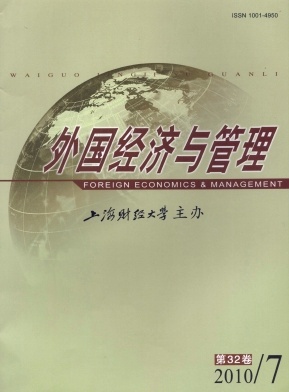组织公正氛围研究现状探析与未来展望
外国经济与管理 2010 年 第 32 卷第 07 期, 页码:24 - 30
摘要
参考文献
摘要
公正氛围是指组织中群体或团队对其是否受到公正待遇的一种群体层面的认知,包括水平和强度两个维度。本文从公正氛围的概念界定、测量、影响因素和作用结果四个方面对国外的主要研究成果进行了系统的梳理和评析,最后对未来的相关研究进行了展望。
[1]Naumann,S E,and Bennett,N.Acase for procedural justice cli mate:Development andtest of a multilevel model[J].Academy ofManagement Journal,2000,43(5):881-889.
[2]Morgeson,F P,and Holf mann,D A.The structure andfunction of collective construct:I mplications for multilevel research andtheory development[J].Academy of Management Review,1999,24(2):249-265.
[3]Cropanzano,R,Goldman,B M,and Benson,L.Organizational justice[A].in J Barling,K Kelloway,and M Frone(Eds.).Handbook of work stress[C].Thousand Oaks,CA:Sage,Publications,2005:63-87.
[4]Colquitt,J A,Noe,R A,and Jackson,C L.Justice in teams:Antecedents and consequences of procedural justice cli mate[J].Personnel Psychology,2002,55(1):83-109.
[5]Spell,C S,and Arnold,TJ.A multi-level analysis of organizational justice cli mate,structure,and employee mental health[J].Journal of Management,2007,33(5):724-751.
[6]Naumann,S E,and Bennett,N.The effects of procedural justice cli mate on work group performance[J].Small Group Research,2002,33(3):361-377.
[7]Yang,J,Mossholder,K W,and Peng,T K.Procedural justice cli mate and group power distance:An examination of cross-levelinteraction effects[J].Journal of Applied Psychology,2007,92(3):681-692.
[8]Chan,D.Functional relations among constructsinthe same content domain at different levels of analysis:Atypology of composi-tion models[J].Journal of Applied Psychology,1998,83(2):234-246.
[9]Roberson,Q M.Justicein teams:The effects of interdependence andidentification on referent choice andjustice cli mate strength[J].Social Justice Research,2006,19(3):323-344.
[10]Mayer,D,Nishii,L,Schneider,B,and Goldstein,H.The precursors and products of justice cli mates:Group leaderantecedents and employee attitudinal consequences[J].Personal Psychology,2007,60(4):929-963.
[11]Ehrhart,MG.Leadership and procedural justice cli mate as antecedents of unit-level organizational citizenship behavior[J].Per-sonal Psychology,2004,57(1):61-94.
[12]Lin,S P,Tang,T W,Li,C H,Wu,C M,and Lin,H H.Mediating effect of cooperative normin predicting organizational citi-zenship behaviors fromprocedural justice cli mate[J].Psychological Reports,2007,101(1):67-78.
[13]Tangirala,S,and Ramanujam,R.Employ silence on critical work issues:The cross-level effects of procedural justicecli mate[J].Personnel Psychology,2008,61(1):37-68.
[14]Li,N,Liang,J,and Crant,MJ.The role of proactive personalityinjob satisfaction and organizational citizenship behavior:Arelational perspective[J].Journal of Applied Psychology,2010,95(2):395-404.
[15]Chen,X P,Lam,S S K,Naumann,S E,and Schaubroeck,J.Group citizenship behavior:Conceptualization and preli minarytests of its antecedents and consequences[J].Group and Organizational Review,2005,1(2):273-300.
[16]Moliner,C,Martinez-Tur,V,Peiro,J M,Ramos,J,and Cropanzano,R.Relationship between organizational justice andburnout at the work-unit level[J].International Journal of Stress Management,2005,12(2):99-116.
[17]Liao,H,and Rupp,D E.Thei mpact of justice cli mate andjustice orientation on work outcomes:Across-level multifoci frame-work[J].Journal of Applied Psychology,2005,90(2):242-256.
[18]Jin,Y H.Collective goal orientation andjustice cli mate on teamlearning[R].International Conference on Computer Science andSoftware Engineering,2008.
[19]Li,A,and Cropanzano,R.Atheory of intraunit justice cli mate and teameffectiveness[R].Paper presented at the annual meet-ing of the Academy of Management,Anahei m,CA,2008.
[20]Walumbwa,O F,Hartnell,A C,and Oke,A.Servant leadership,procedural justice cli mate,service cli mate,employee atti-tudes,and organizational citizenship behavior:Across-level investigation[J].Journal of Applied Psychology,2010,95(3):517-529.
[2]Morgeson,F P,and Holf mann,D A.The structure andfunction of collective construct:I mplications for multilevel research andtheory development[J].Academy of Management Review,1999,24(2):249-265.
[3]Cropanzano,R,Goldman,B M,and Benson,L.Organizational justice[A].in J Barling,K Kelloway,and M Frone(Eds.).Handbook of work stress[C].Thousand Oaks,CA:Sage,Publications,2005:63-87.
[4]Colquitt,J A,Noe,R A,and Jackson,C L.Justice in teams:Antecedents and consequences of procedural justice cli mate[J].Personnel Psychology,2002,55(1):83-109.
[5]Spell,C S,and Arnold,TJ.A multi-level analysis of organizational justice cli mate,structure,and employee mental health[J].Journal of Management,2007,33(5):724-751.
[6]Naumann,S E,and Bennett,N.The effects of procedural justice cli mate on work group performance[J].Small Group Research,2002,33(3):361-377.
[7]Yang,J,Mossholder,K W,and Peng,T K.Procedural justice cli mate and group power distance:An examination of cross-levelinteraction effects[J].Journal of Applied Psychology,2007,92(3):681-692.
[8]Chan,D.Functional relations among constructsinthe same content domain at different levels of analysis:Atypology of composi-tion models[J].Journal of Applied Psychology,1998,83(2):234-246.
[9]Roberson,Q M.Justicein teams:The effects of interdependence andidentification on referent choice andjustice cli mate strength[J].Social Justice Research,2006,19(3):323-344.
[10]Mayer,D,Nishii,L,Schneider,B,and Goldstein,H.The precursors and products of justice cli mates:Group leaderantecedents and employee attitudinal consequences[J].Personal Psychology,2007,60(4):929-963.
[11]Ehrhart,MG.Leadership and procedural justice cli mate as antecedents of unit-level organizational citizenship behavior[J].Per-sonal Psychology,2004,57(1):61-94.
[12]Lin,S P,Tang,T W,Li,C H,Wu,C M,and Lin,H H.Mediating effect of cooperative normin predicting organizational citi-zenship behaviors fromprocedural justice cli mate[J].Psychological Reports,2007,101(1):67-78.
[13]Tangirala,S,and Ramanujam,R.Employ silence on critical work issues:The cross-level effects of procedural justicecli mate[J].Personnel Psychology,2008,61(1):37-68.
[14]Li,N,Liang,J,and Crant,MJ.The role of proactive personalityinjob satisfaction and organizational citizenship behavior:Arelational perspective[J].Journal of Applied Psychology,2010,95(2):395-404.
[15]Chen,X P,Lam,S S K,Naumann,S E,and Schaubroeck,J.Group citizenship behavior:Conceptualization and preli minarytests of its antecedents and consequences[J].Group and Organizational Review,2005,1(2):273-300.
[16]Moliner,C,Martinez-Tur,V,Peiro,J M,Ramos,J,and Cropanzano,R.Relationship between organizational justice andburnout at the work-unit level[J].International Journal of Stress Management,2005,12(2):99-116.
[17]Liao,H,and Rupp,D E.Thei mpact of justice cli mate andjustice orientation on work outcomes:Across-level multifoci frame-work[J].Journal of Applied Psychology,2005,90(2):242-256.
[18]Jin,Y H.Collective goal orientation andjustice cli mate on teamlearning[R].International Conference on Computer Science andSoftware Engineering,2008.
[19]Li,A,and Cropanzano,R.Atheory of intraunit justice cli mate and teameffectiveness[R].Paper presented at the annual meet-ing of the Academy of Management,Anahei m,CA,2008.
[20]Walumbwa,O F,Hartnell,A C,and Oke,A.Servant leadership,procedural justice cli mate,service cli mate,employee atti-tudes,and organizational citizenship behavior:Across-level investigation[J].Journal of Applied Psychology,2010,95(3):517-529.
引用本文
王怀勇, 刘永芳. 组织公正氛围研究现状探析与未来展望[J]. 外国经济与管理, 2010, 32(7): 24–30.
导出参考文献,格式为:





 7355
7355  596
596

